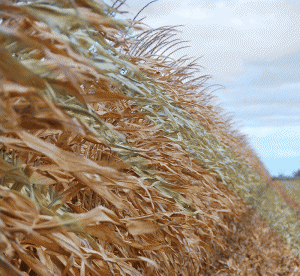Understanding precision agriculture
LESSONS FROM THE FIELD
Precision Agriculture Advancement for Ontario: This article is part of a series dedicated to helping farmers understand and implement precision agriculture technology. Next month we focus on how to best utilize field maps and management zones.
For more on precision agriculture go to: www.gfo.ca/Research/Understanding-Precision-Ag
_______________________________________________________________________________
Recapping the first year of the Precision Agriculture Advancement for Ontario project.
A GROWING NUMBER of farmers are taking up precision farming techniques and investing in equipment outfitted with the latest GPS mapping, precision planting, and yield monitoring technology.

But still, several burning questions remain for those who haven’t yet taken the plunge. Will this investment translate into higher profitability and benefit their land in the long run? How does one develop a fine-tuned agronomic approach that carefully matches their input rates to the most (and least) productive areas of their fields?
Those questions — and more — are what Grain Farmers of Ontario and a team of extension specialists from the Ontario Ministry of Agriculture, Food and Rural Affairs (OMAFRA), researchers, crop consultants, equipment retailers, and farmer cooperators are trying to answer during the three-and-a-half-year Precision Agriculture Advancement for Ontario project.
With year one complete and year two of the project into harvest, what has the research team learned, what do they need to get a better grip on, and what do they need to know next?
For OMAFRA crop innovations specialist Ian McDonald, the project’s success and main objective is to create a series of case studies. These are real life examples of precision agriculture in action on fields across Ontario that will help drive home the message of its economic and environmental benefits.
“We want to have real on-farm data that the farmer can actually use and apply, as opposed to looking at research that might not work on their farm,” says McDonald. “The early adopters had a feeling in their gut that the precision ag approach worked and we know that a lot of growers may be interested, but they want us to show them that the investment is actually worth it.”
UNDERSTANDING DATA
A big piece of the project so far has involved gathering a number of data layers from the case study fields, such as yield, soil fertility, electrical conductivity, soil texture, and elevation.
The layers are then analyzed and processed with specialized software by a team of consultants at Niagara College in order to create management zones — areas within a field that have a similar yield potential.
Mapping out these management zones can help farmers manage poorer performing parts of their fields differently from the highest-yielding areas year after year.
“If I can see that I’ve got a highly productive area that’s lower elevation, and has good soil with high organic matter that holds moisture, I can take advantage of that by increasing my seeding population,” says McDonald. “On a dry knoll, on the other hand, I know I’m going to have more competition for moisture and nutrients.”
Right now, McDonald and the research team are working to create and apply prescription maps for each management zone that focus on input variables that the individual farmer cooperators are most interested in; such as fertilizer rates and plant populations.
McDonald says that the next step for the research team is to validate the prescription maps and management zone delineations (the exact location in the field where one zone ends and another begins) to determine if they’re stable from season to season and can be managed using variable input rates to improve profitability.
OMAFRA corn specialist Ben Rosser has been taking a closer look at each data layer to find out which information sources are most useful to farmers when creating a prescription map for their management zones.
“When you’re developing prescription maps, you’re basing your decisions on maybe one or even multiple layers,” explains Rosser. “Hopefully, by the end of this project, we’ll be able to identify which layers or combinations of layers are going to best show the differences in response to nitrogen rates and plant populations.”
RESULTS
As for what the project team has seen from the management zones across the province, OMAFRA land resource specialist Nicole Rabe calls the results “mixed” so far, but emphasizes that it’s still too early to draw any major conclusions.
“I think everything hinges on the stability of the management zones from year to year,” she explains. “We’ve had quite a bit of variation in the precision ag equipment as well as the experience level of our farmer cooperators – from beginners to very advanced.”
To get the precision agriculture project underway, Rabe and McDonald worked with several local consultants to gather a group of 20 farmer cooperators from across the province with experience in precision agriculture.
Initially, Rabe says that they wanted farmer cooperators with at least five to 10 years of yield data — but then quickly found those farmers were few and far between. Even if a farmer had several years of yield data on hand, it was often incomplete.
“We’re now realizing that our management of data is a big part of the problem when it comes to farmers being willing to adopt precision agriculture practices,” says Rabe. “We need to start talking about it and educating farmers on how to fully maximize their equipment and make better use of all the data they’re gathering.”
Data that is of poor quality, missing, or incompatible between different pieces of equipment and software can’t be used. This makes protecting data from getting lost or corrupted all the more important.
Along with educating about why it’s important to collect and manage yield data, Rabe says that the project team is still trying to find the best way to present data to growers and validate whether the nitrogen and population rate prescriptions were a good fit in a particular area of the field.
CROP PORTAL
The first year of the Precision Agriculture project also saw the launch of the Crop Portal, an online repository where growers can upload raw yield data flowing in from their combines, have it processed and then get management zone maps for their fields that spatially define high, medium, and low-yielding areas.
Leading the Crop Portal development is Dr. Mike Duncan, Natural Sciences and Engineering Research Council of Canada (NSERC) industrial research chair, Sarah Lepp, senior research associate, and Gregor MacLean, research project manager from Niagara College.
Lepp says that she and her fellow researchers have been focused on developing specialized computer algorithms that help with cleaning and processing the raw yield data uploaded to the Crop Portal.
Cleaning data involves removing unusually high spikes or extremely low yield numbers that could be caused by issues such as an equipment malfunction or high pest pressure in a pocket of the field.
“The question is how do we appropriately and effectively clean and present data without removing bits of data that could actually point to a real problem,” explains Lepp. “We’re working to help growers who are already collecting data to make sense of it and give them a useable, accurate picture of how their fields are actually performing.”
McDonald says that the work being done through the Crop Portal is helping move farmers beyond looking at basic yield maps and towards an integrated analysis of multiple data layers that allows them to segment their fields into management zones — each with their own input prescriptions that can be tweaked and adjusted to maximize productivity.
“Now we have the ability to put yield maps to work as part of the production tool box so that the best decisions can be made in how to manage the crops,” he says.
Even with multiple data layers being collected, analyzed, and made available to growers, Rabe says the project team’s best asset in the precision agriculture project has been building close-knit relationships with local farmer cooperators.
“You need good soil and climate information and that regional perspective,” she says. “It’s fairly detailed information that you get from relationships with the growers that is going to help make the best precision agriculture decisions — and I don’t see that ever going away.” •























